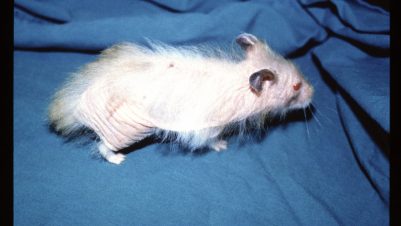- Ehlers-Danlos syndrome refers to a group of inherited connective tissue disorders resulting in defective collagen synthesis.
- Initially described in humans by dermatologists Edvard Ehlers from Denmark and Henri Danlos from France at the beginning of the 20th century.
- Since then, seven major types have been described in people, affecting the joints, skin and blood vessels. The most common type involves hypermobility of joints. Classical types 1 and 2 involve the skin to varying degrees of severity. The dermatosparaxis form with extremely fragile and easily torn skin is very rare in people.
- In domestic animals the disorder has been described in sheep, cattle, mink, dogs and cats (Grif n and others, 2013). Disorders of skin extensibility have been described in the majority of cases.
Clinical features in dogs and cats
- As the disease is inherited, young animals are predisposed.
- “Stretchy” skin which can be stretched to extreme lengths and may hang loosely in folds, particularly near joints of the limbs.
- The skin tears easily and relatively minor trauma can produce large gaping wounds with minimal haemorrhage.
- In those cases that have not been diagnosed earlier there is often a history of frequent visits to the veterinary clinic in order to suture wounds.
- Even with careful suturing the wounds may break down and scarring is a common sequel.
- Joint hypermobility may rarely be seen.
- A recent article described simultaneous involvement of the vascular system in a dog with fatal consequences (Uri and others, 2015).
Differential diagnosis
- There are no differential diagnoses in the dog that mirror this clinically distinct syndrome.
- In the cat, acquired skin fragility syndrome will manifest as extremely fragile skin that tears easily. The fragility is more pronounced than Ehlers-Danlos syndrome and extensive tearing often occurs. There is an underlying hyperadrenocorticism in the majority of cases. The disease occurs in old cats.
Diagnosis
- History and physical examination. Cases may be diagnosed at the initial veterinary consultation, as the clinical picture is very suggestive.
- Repeated minor trauma leading to tearing of the skin and a requirement for suturing is common and suggests the need for further investigation. Wound healing may be delayed or a wound breakdown following suture removal can be a problem.
- Animals may be seen with scarring from previous episodes of wounds that have healed by second intention.
- A skin extensibility index has been described (Patterson and Minor, 1977). This is a function of the vertical height of the skin fold divided by the body length multiplied by 100. A figure greater than 14.5% in dogs and 19% in cats is reportedly diagnostic for the condition (Freeman and others, 1987).
- Skin biopsy. It is useful to advise the histopathologist of the provisional diagnosis. Staining with haematoxylin and eosin may demonstrate abnormal collagen but is frequently non-diagnostic. Masson’s trichrome stain has been reportedly more useful (Fernandez and others, 1998). Collagen fibres appear fragmented with variations in length and diameter with disarray of orientation. Electron microscopy may be diagnostic if doubt exists following routine histopathological examination.
Clinical management
- Inform the owner that the disease is inherited and incurable and animals should not be bred from.
- Cats are best kept indoors. Dogs can be walked on a leash away from vegetation with thorns or other sharp points.
- A risk assessment is made of rooms inside the house checking for sharp edges on furniture for example and removing these or applying protective devices.
- There should be preventive measures against any skin disorders that could prompt a pruritic response. Nails and claws should be kept short and blunt.
- Any wounds are promptly treated using mattress sutures with minimal tension and allowing extra time for healing to take place.
- With care, affected animals can live their normal life span, although repeated trauma episodes requiring wound treatment may prompt a request for euthanasia.
References
- Fernandez, C. J. and others (1998) Staining abnormalities in dogs and cats with cutaneous asthenia or acquired skin fragility as demonstrated with Masson’s trichrome stain. Vet Derm 9: 49.
- Freeman, L. J. and others (1987) Ehlers-Danlos syndrome in dogs and cats. Semin Vet Med Surg 2: 221.
- Miller, W. H., Grif n, C. E. and Campbell, K. L. (2013) In: Muller and Kirk’s Small Animal Dermatology, 7th edition; pp602-604.
- Patterson, D. F. and Minor, R. R. (1977) Hereditary fragility and hyper- extensibility of the skin of cats. Lab Invest 37: 1,470.
- Uri, M. and others (2015) Ehlers-Danlos syndrome associated with fatal spontaneous rupture in a dog. Journal of Comparative Pathology 152 (2-3).








-1628179421-401x226.jpg)


